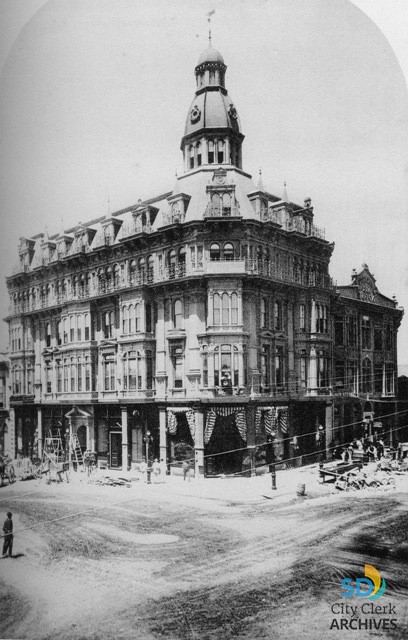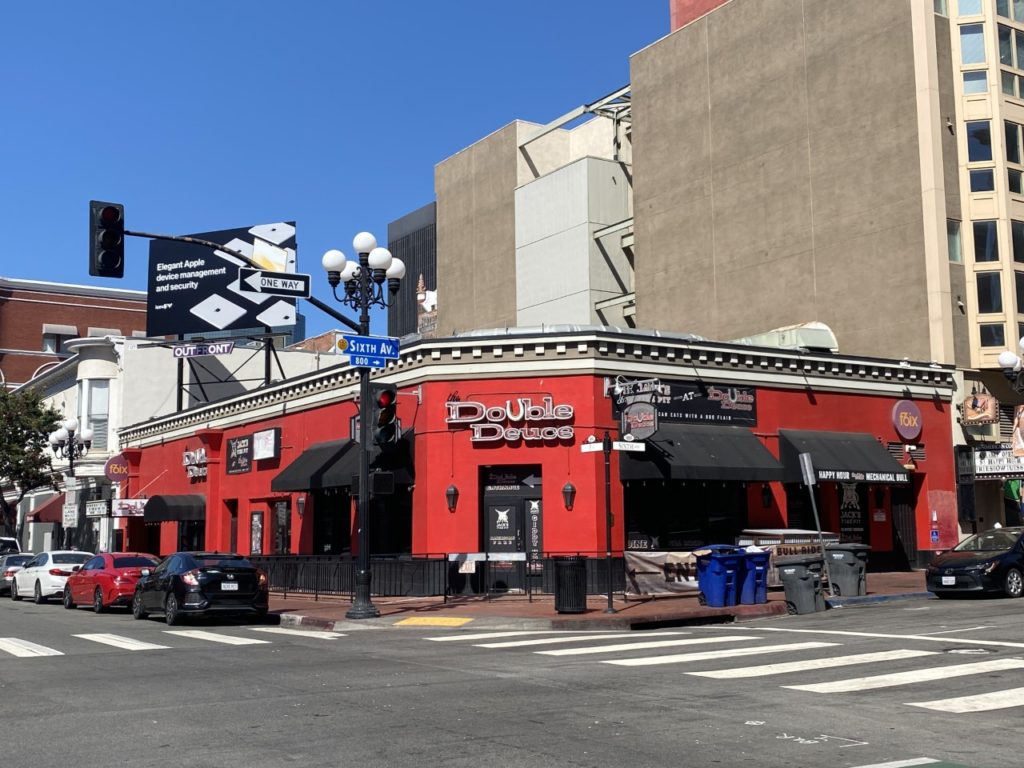No products in the cart.
Landmarks
Gone, but Not Forgotten…
Pierce-Morse Building(1887)
Sixth Avenue & F Street
Architects: Comstock and Trotsche
Architectural Style: Italianate / Commercial
John Keats once said that “A thing of beauty is a joy forever.” That might be said of the Pierce-Morse Building, an important part of the San Diego skyline of the late 1800s and the first part of the 20th century. The building has a long and interesting history, and boasts a bevy of notable personalities who added to San Diego’s history, as well as to that of the building. They include James M. Pierce, Ephraim W. Morse, Dr. Emma Read, Cassius Carter, and E.M. Capps.
Alonzo Horton originally sold two adjoining lots on the corner of F Street to George Hyde of San Francisco for $700 in gold coin. In slightly less than four years, Mr. Hyde turned a tidy profit by selling the same lots to Ephraim W. Morse for $1,600 in gold coin.
Mr. Morse was a pioneer, farmer, teacher and capitalist. He came to California during the Gold Rush, and like Alonzo Horton, was drawn to San Diego for the healthful climate. He became an associate judge of San Diego County, a member of the first County Board of Supervisors , a founder of the Bank of San Diego and the auctioneer when Alonzo Horton purchased the land for New Town. He and Horton be-came such good friends that they selected the site for City Park (Bal-boa Park) together, and Morse served as best man at Horton’s marriage to Lydia Knapp. Morse and his wife, Mary Chase Walker, San Diego’s first schoolteacher, hosted the wedding in the parlor of their home. State Supreme Court Associate Justice, John D. Works, officiated, and afterwards the Morses hosted everyone to an elegant lunch-eon. Upon Morse’s death in 1905, Horton stated, “There is no man that has been truer to the interests of San Diego than E. W. Morse.” Morse chose Pierce as a business partner when he sold him a half interest in the two lots on F Street for $800 in gold coin.
James Pierce also had a history of civic involvement. He replaced Horton as a trustee of the San Diego Library Association, was nomi-nated for State Assembly, and was president of the San Diego Cham-ber of Commerce. Pierce died suddenly in early 1887 with no known relatives or children, and his formidable estate was not settled until 1895.
The building’s construction had already begun prior to Pierce’s passing, but the early details of the development are meager. However, the magnificent structure emerged in bold relief in June of 1887. It was five stories plus a large basement . The fifth story was capped by a tower accessed from the fifth floor, which could be used as an observatory or smoking room. Elegant and formidable, it could be seen from out at see, and definitely changed the skyline of San Diego.
The basement itself was a wonder. It was to be used as a restaurant, with the exception of the southeast corner, which was reserved to house the power supply for the elevator and lighting. The space under the sidewalk was to be illuminated by prismatic skylights. The hall was 114’ by 64’ with a cement floor and attractive iron uprights at intervals to support the floors above it. A Westinghouse hydraulic pump was in-corporated to pump water to the upper floors, as well as a Westing-house dynamo to power the Edison incandescent lights. The lights were regulated in each room by pushing a button to turn them on.
The first floor was divided into six large spaces with full length plate glass windows. The rooms were finished with hand-carved base-boards and moldings, and stained glass transoms over the windows. The main entrance, located on “F” Street, opened onto a broad hallway leading to stairs to the second floor. The stairs, shallow and easy to ascend, broke on a landing halfway up to the second floor, where the elevator was located.
The second floor featured a large, wide hallway with shorter halls bi-secting it, which led to offices and suites. At the end of the hall was a large plate glass window with a stained glass transom above it.
The third floor was reached by another flight of stairs with carved oak handrails and landing posts. This floor was an exact replica of the sec-ond floor, but with a better view.
The fourth floor or “balcony” floor, was considered the “gem,” as it was wainscoted with polished redwood and heavy paneled doors. The large windows were square, and could be lifted so that one could step out onto a balcony.
The Mansard, or attic space beneath the roof, was designed for use as lodgings or offices. The rooms were complete with closets, full bathrooms and small balconies.
Fire provisions were also made for this magnificent structure, as each floor had coils of hoses attached to the water main and fire extinguish-ers.

Early occupants were Comstock and Trotsche, the architects of the structure, as well as lawyers, doctors, civil engineers, real estate agents and Mr. Morse. Prominent lawyers were Judge Moses Luce, his partner, J.J. Henderson, and Cassius Carter. Mr. Carter was an or-ganizer and founder of the Cuyamaca Club, and was considered one of the foremost Shakespearean scholars of his time. A stage at the Old Globe Theater commemorates his name.
E.M. Capps, a civil engineer, who was active in planning the Broad-way Pier and prepared plans for the million dollar harbor expansion, had his offices in the building. He, additionally, developed a rapid firing gun, served two terms as Mayor and acted as City Engineer for ten years.
No list of prominent tenants would be complete without mentioning Dr. Emma T. Read. Dr. Read is considered one of the pioneer women dentists of her time. Despite the male dominance of her era, she was very successful, and was one of four females to be licensed out of a class with 56 men. She also helped many young people get an education, and gave a home to old and needy citizens. Dr. Read remained in the building until 1923.
Unfortunately, by the mid 1950s, old age and weather damage had taken its toll on the Pierce-Morse Block, and this necessitated the demolition and removal of the upper floors. At this time historical perspectives and restoration techniques were not implemented. Consequently, all that remains of this splendid and iconic structure are remnants of the original basement and first floor. The front of the building has been covered with stucco and inlaid with tiles. It does not reflect either the grandeur of the old building or the theme and motif of the Gaslamp. The Pierce-Morse may be gone, but the structure and the era it represented are not forgotten.

